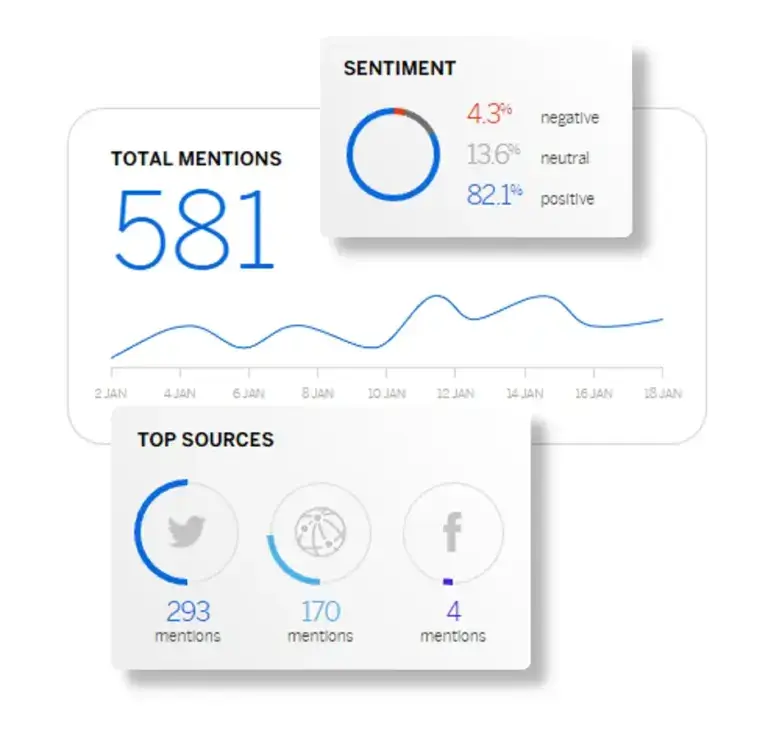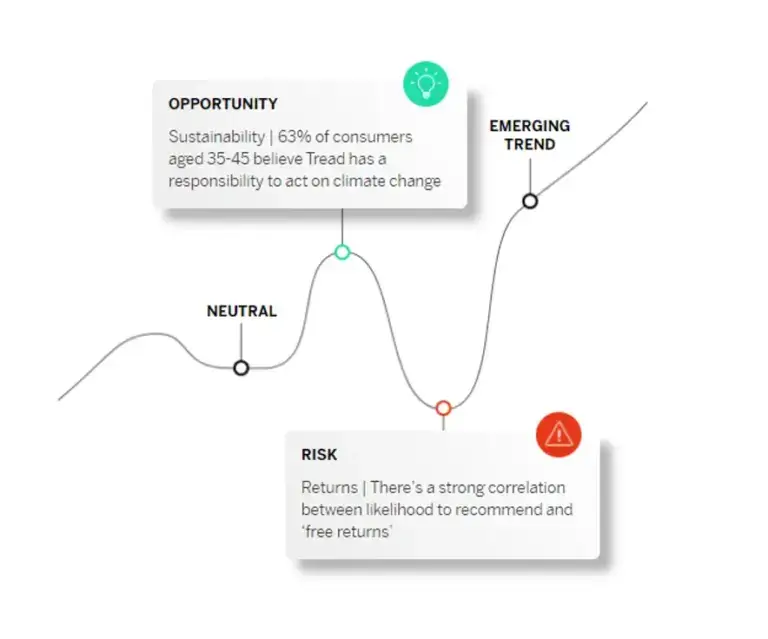What is brand sentiment?
Brand sentiment is the name given to the feelings your brand inspires. For example, consumers and the wider market might feel positive, neutral and negative about your brand.

This might be expressed in third-party reviews, submitted in consumer feedback, shared on social media, spread through word-of-mouth recommendations or more. It’s not just about how your brand appears externally – brand sentiment can also refer to how your employees view your company from the inside.
Brand sentiment gives you the emotional context behind consumer mentions of your brand online – but it becomes even more powerful when you can isolate the sentiment around specific topics being mentioned. This gives you an understanding of positive brand perceptions as well as barriers for consumers.
A consumer can have positive perceptions around one particular area of your business – say product quality – but they may perceive other aspects negatively, such as the price point for your products or services. Your overall brand sentiment will give you insight into how positively or negatively your brand is perceived overall. Ideally, you’ll surfact brand sentiment insights on the root causes of why your brand is perceived a certain way.
You can measure brand sentiment with the power of artificial intelligence and machine learning , combined with Natural Language Understanding (NLU). Analyzing text inputs (such as open-text survey responses or social media posts) is made easier with tools that can recognize indicators of sentiment and automatically assign them as positive, neutral or negative in tone.
Free eBook: The ultimate guide to building a world-class brand tracker
Keep reading to find out why brand sentiment can provide ROI, how to measure it and what “good” brand sentiment looks like.
Why is brand sentiment important?
Brand sentiment is important because it measures intangible and often hard-to-quantify feelings surrounding a brand, while also highlighting factors that can have a significant impact on your business outcomes.
Measuring brand sentiment might not feel as important or as simple as measuring more easily quantifiable business metrics, such as NPS or CSAT, but positive sentiment is a great indicator of consumer loyalty, potential consumer spend, employee retention and more.
Similarly, negative sentiment can be a strong indicator of high consumer churn, negative brand image or problems with how your brand operates.
It’s also important to track brand sentiment to keep up with the competition. In 2020, 54% of brands stated that they had started using consumer sentiment analysis tools on reviews and social media, with the expectation that this figure would exceed 80% in 2023. To stay ahead of the pack, you’ll need to use this valuable tool to provide better services and hone in on what your consumers really want from your brand.
We found that 63% of consumers think that brands need to do a better job of listening to feedback. Brands that use brand sentiment analysis will be able to not only take solicited feedback, but find new ideas in unsolicited feedback as well. This means brands can better meet expectations and even exceed them, proving that they’re listening to consumers wherever they’re making their views known.
Why should you track brand sentiment over time?
As your brand evolves, introduces new products and launches new marketing strategies, how your brand is perceived will change. Tracking brand sentiment over time helps you to build a picture of what shifts consumer sentiment and predict what will happen to your brand’s reputation if you make certain changes.
What is “good” brand sentiment and why do you need it?
“Good” sentiments about your brand might include:
- High quality and consistent products and services
- Helpful staff
- Great value for money
- Good value for money
- Clear and transparent interactions with consumer service
Negative sentiments about your brand could be:
- Bad or misleading products or services
- Feeling lied to about your brand’s values
- Upset about your consumer service
- Angry about your marketing strategy
However, sentiment is very subjective, and what might be negative for one brand might be positive for another and vice versa. “Cheap” might be counted in negative mentions for a luxury brand, but could be positive for a value-for-money brand.
Why do you need “good” brand sentiment?
How consumers feel about your brand can greatly influence their behavior, and give you insight into brand consideration and purchase intent.
For example:
Does your audience think your brand is consistent in providing great quality services? They’re more likely to return and recommend your brand as a result.
Is your audience upset with your consumer service and being vocal about it online? When potential consumers are searching social media, search engine results and third-party reviews for information on your brand, they’ll see these negative brand mentions and form an opinion accordingly. This might prevent consumers from coming back or new consumers from even getting involved.
How do you measure brand sentiment?
To measure brand sentiment, you’ll need to undertake a brand sentiment analysis. Brand sentiment analysis is the process of pinpointing opinions, emotions and judgements of your brand through the dissection of natural language inputs, such as open text comments, social media posts, or transcripts of consumer phone calls. It’s completed with a sentiment analysis tool, usually software that can automatically “read” inputs and flag text with a positive, negative or neutral tone.

Determining sentiment through Natural Language Understanding (NLU)
Positive sentiment, neutral sentiment and negative sentiment might seem simple to understand at first glance, but there are several factors that can make brand sentiment more nuanced. A major one is the fact that human beings express themselves in natural language, which can often be tricky for digital tools to parse for sentiment.
Brand sentiment can be significantly affected by the power of your brand analysis tools. Often, brand sentiment can be complex, with shades of positivity and negativity. Your brand analysis tool should be able to flag if comments are particularly positive or only somewhat negative.
For example:
Your brand receives a survey response that has the comment: “ [Brand] products and their consumer service are excellent, but I find all of the prices are too expensive.”
A great sentiment analysis tool will be able to flag the following:
- The “Product” topic is very positive, because “excellent” is one of the positive words the tool recognises.
- The “consumer service” topic is very positive for the same reason.
- The “Price” topic is negative, because the tool can recognize that the qualifier “too expensive” is negative.
- Overall, the brand sentiment is mostly positive.
Without a good understanding of how natural language works, brand sentiment analysis tools can incorrectly flag the tone of a comment. For example, it can be difficult to detect sarcasm if your sentiment analysis tool isn’t properly calibrated and is powerful enough to understand how people tend to express themselves.
Sources for brand sentiment analysis
You can use many inputs as a source for your brand sentiment analysis, including:
- Open text feedback on consumer feedback surveys
- Comments or posts on social media platforms
- Online reviews on third party websites
- Forums and blogs
- Focus groups
- Clients’ feedback over email
- Online conversations on your live chat website function
- Telephone transcripts from your consumer service calls
Why do you need more than social sentiment analysis?
Social sentiment analysis can help you to pinpoint positive mentions or negative reactions by using social media listening and sentiment analysis tools. While social media monitoring for brand sentiment is important, focusing solely on it only provides you with part of the story.
Analyzing sentiment from current consumers in what they actually say to you in consumer service calls, in focus groups, in reviews and more can give you a wider view of what your engaged audience feels passionate about, and what they’d like to see changed. If they’re expressing their concerns to you, there’s still a chance to turn a negative experience around. When you only analyze brand sentiment from one channel, you’re missing out on the whole picture.
Analyzing sentiment across all channels where a consumer may be interacting with your brand can give you a wider view of what your engaged audience feels passionate about, and what they’d like to see changed. You will be able to better understand how your brand is perceived and why it is perceived in that way. When you only analyze brand sentiment from one channel, you’re missing out on the whole picture.
What’s the difference between text analytics and sentiment analysis?
Though they might seem similar, text analytics is the analysis of unstructured text to extract useful information and find business intelligence insights. In contrast, sentiment analysis pinpoints whether a written expression is positive, neutral or negative in nature and to what level. Both are very useful in understanding your brand health and how to improve how your brand is perceived by consumers.
Calculating brand sentiment
As mentioned, calculating brand sentiment requires the right sentiment analysis tools. The process of brand sentiment analysis as a whole can be divided into these actions:
1. Find the right brand sentiment analysis tool
Calculating brand sentiment requires a sentiment analysis tool that can collect large quantities of data, process it appropriately and deliver insights that are targeted and relevant. Features to look out for in a sentiment analysis tool are:
- Always-on and real-time sentiment analysis (with a more nuanced analysis than just Positive, Neutral and Negative sentiment) and a sentiment score to help you track and improve over time
- Data collection from every channel (social media, third-party online reviews, consumer service conversations, employee feedback etc.)
- AI-powered conversation analytics with Natural Language Understanding (NLU) built on comprehensive data models
- Automatic trend and insight discovery
- Automatic delivery of insights to appropriate teams
2. Collect your data
The more data you collect, the better an understanding you will gain about general brand sentiment and your brand’s reputation. Gathering data such as open-text responses on consumer satisfaction surveys, comments from social media platforms, employee feedback forms and more will give you a thorough understanding of your brand’s public image.
You can also collect data not just on what is being said and the sentiment behind it, but how often it’s being said (the velocity). You can combine your sentiment analysis, the velocity analysis and common engagement metrics (such as number of views, reactions etc.) to help pinpoint how popular a particular viewpoint is, and give you real-time leading indicators of change.
3. Implement your sentiment analysis
Your sentiment analysis tool will take your collected data and assign tags, flagging items with the appropriate sentiment (such as Very Negative, Negative, Neutral, Positive, Very Positive or Mixed Sentiment). You’ll also get a sentiment score to help you quantify the results you’re seeing.
4. Get insights
Insights you should be able to glean from your sentiment analysis should include:
- Sentiment score: How does your brand sentiment measure up?
- Opportunities: Where can you transform neutral or negative sentiment into positive sentiment, and which actions will achieve this goal?
- Emerging trends: What are people talking about in the context around your brand mentions, and are they positive or negative? How can you leverage these trends?
- Risks: What is causing the most negative impact on your brand sentiment? What can be changed and how?
- Competitive Analysis: How is my brand perceived compared to my competitors? In which specific areas is my brand perceived as better or worse than others?

Once you have these insights, they should be delivered to the relevant team members with actions to implement. For example, if your consumers believe sustainability should be a greater focus, your marketing strategy can help to flag your already-existing initiatives and any planned ones for the future.
5. Take action
The final step is to take action to improve, based on your insights. Read on to find out how to improve your brand sentiment.
How do you improve brand sentiment?
Improving brand sentiment means taking action when negative or neutral sentiment is flagged. Your brand sentiment analysis should always be ongoing, but your resulting responses and updates should be ongoing as well.
Take these suggested actions, for example:
Check specific brand campaign reactions
Campaign performance analysis is a great way to measure exactly how your marketing strategy is doing, and how your audience is receiving it. Rather than just measuring whether a marketing campaign has increased sales, by measuring brand sentiment you can also learn whether it’s improving the attitude towards your brand.
Learn from past campaigns
Check what’s driving your engagement across your channels and figure out how this impacts sentiment and use this knowledge to adjust your campaigns accordingly. Does video have a better response than static ads on brand sentiment? Does promoting a particular message resonate more? What topics generated the most interest in your brand? When you turn brand listening on continuously, you’ll be able to effectively transform social media sentiment analysis and more into ideas for successful future campaigns.
Train your consumer service team more effectively
With sentiment analysis across your social media platforms, in your consumer service interactions, and on a broader scale across all of your channels, you’re able to see which topics cause a negative reaction and which actions inspire a positive response. With this knowledge, you can train your consumer service teams, improve consumer experiences and make your employees’ jobs easier by giving them data-led actions to take.
Close the loop with unhappy consumers
When consumers aren’t getting the brand experience they’re looking for, they may become vocal online. With sentiment analysis, you can pinpoint where your team can close the loop publicly. This helps not only those specific consumers, but also to help demonstrate that your brand cares about consumer experiences. Make sure to get in touch quickly to remedy the situation and offer a meaningful outcome.
Meet and exceed consumer expectations
With in-depth media monitoring and social media sentiment analysis, you’ll soon learn the topics and trends your consumers care about. You can take ideas from your consumers that have a positive sentiment and replicate them, or simply promote them more effectively. For example, if free shipping improves the likelihood to recommend, keeps consumers loyal and inspires positive brand sentiment, implementing this change – and letting your consumers know about it – can go a long way to improving your brand health and sentiment.
Quickly improve your business processes
You can also improve business processes or areas that inspire negative sentiment. If your consumers are frequently negative about your consumer service department, implement changes and let your consumers know what’s new to help transform this sentiment into something positive.
Complete granular product analysis
You can also analyze and understand areas in which your products might need improvements, particularly where there may be a need for changes for specific customer segments. This data can help you to inform your product teams of specific changes that will be better received, leading to better brand perception and ideally improved brand sentiment.
See what your competitors are doing well
You don’t just need to keep an eye on the perception of your own brand – there’s also your competitors to think about. Your social media sentiment analysis and analysis of other channels can help you to find out what your competitor companies are doing well and where they’re not fulfilling expectations. You can win over their consumer base by targeting their weaker spots, such as negative sentiment around costs or consumer service, and making them into a unique selling point for your brand.
Building positive brand sentiment with Qualtrics
With XM Discover from Qualtrics, you’re able to constantly measure brand sentiment and other key metrics such as loyalty, intent and consumer effort. Pinpoint trends, mitigate risks and find new opportunities through automatic sentiment analysis across all your channels. Understand exactly what’s being said about your brand and your competitors at any time and on any channel.
Brand listening has never been so simple or so integrated. Find out how you can build great brand sentiment and create positive brand perception with our all-encompassing brand management tool.
Free eBook: The ultimate guide to building a world-class brand tracker